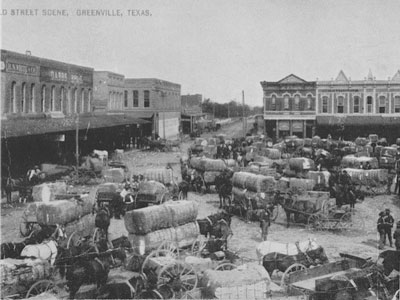
Texas is well-known for its Blackland Prairies, a swath of black, gummy, clay that runs like a tornado from counties adjacent to the Red River southwesterly to beyond Austin. When early settlers from Mississippi and Alabama saw the rich Eco-Region, they were thrilled. Blackland grows great cotton. There was one difference between the Texas Blackland Prairie and that in their home states. Where were the rivers? Yes, there is the Red River, and the headwaters of the Sabine, the Brazos and the Trinity, none of which are navigable this far north. Like all agricultural endeavors, cotton needs not only good soil, moisture, and sun, but the farmer has to have a market so sell his product. To get to that market, it was much easier, quicker, and cheaper to float the bales downriver. There were no rivers deep enough above Falls of the Brazos. Freighting it to Jefferson and shipping down the Sabine to Galveston was an option. That worked if you had sons to do the work. It usually took almost a month.
Railroads were very practical means of transportation. But the only railroad in Antebellum Texas was a short line around Houston. During the Civil War, planters in Arkansas piled bales of cotton in wagons and sent long lines through Texas to the Rio Grande where the cotton bales were unloaded on the Mexico side, then loaded onto British ships in exchange for food, liquor, and medicine for Confederates. It would be late 1870s and early 1880s before rail transportation became available in the state of Texas.
Once railroads were up and running, cotton gins sprouted up on every rural crossroad. Life was good again in Northeast Texas, except for one thing. Railroad lines, such as the Katy in north Texas, charged enormous fees and were not found everywhere like streets and roads are today.
The Katy came into Texas through what is now Denison and ran southeasterly through Greenville. It was October 2, 1880 that the train made its first appearance to a great celebration. Farmers knew of the arrival and planted cotton earlier in the spring. Now cotton and railroads were connected.
Every fall, wagons were lined up at the gins, baled cotton was for sale on the courthouse square, furnishing merchants recouped part of the farmers debts. Cotton sold in Greenville was taken to the compress to be squeezed into tighter bales before they were loaded on trains for Galveston and shipment to Europe. Who paid for this? Most of the time the fee funneled down to the farmer.
The Katy had the round house in Greenville and the county had two attorneys and a judge on their side. Numerous lawsuits were filed at the Hunt County Courthouse in Greenville. One is worth telling. A farmer had taken his cotton to the gin and on returning home, he smelled smoke and discovered his load was on fire or smoldering as cotton does. Approaching a railroad track, he drove over it, stopped his mule to jump off, sent the mule and wagon on. This didn’t work out as he planned. He broke his leg, the mule wandered off, and the wagon with cotton slowly burned.
But, aha, there was another chance to make some money. He visited one of the attorneys, filed a claim against the Katy and won. A little later, the Greenville roundhouse burned to the ground. At that point, the Katy owners decided to teach the attorneys and judge a lesson. They left the remains of the burned roundhouse and built a new one a Denison, a much more friendly railroad town.

I live in Bonham, and found out the old passenger railroad bed that is long gone, is about 2 blocks from my house (found in the 1940 census map). I was fascinated to learn it ran between Denison, Bonham, and Greenville to carry only passengers (DB&NO). There is only the railroad depot left, all the rail lines have long ago been removed. Hardly a ghost left of a roaring time.
Very interesting about floating the bales. I did not know this, I new steamships and why so many towns were founded near river beds to transport cargo via boat, but floating the bales I had never come across. Our fathers who proceeded us were genius!